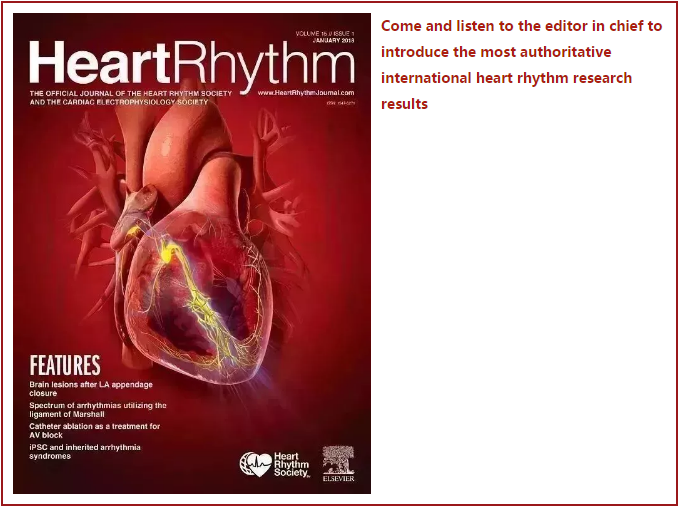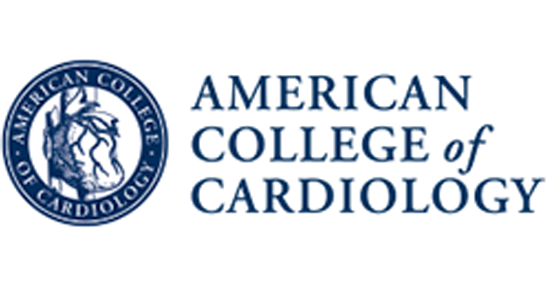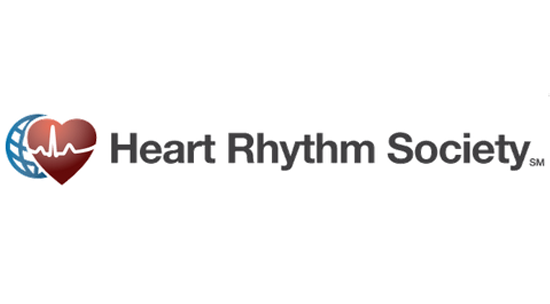HeartRhythm主编—陈鹏生教授语音速递(四月刊 英文版)


1
The featured article this month is “Value of Mapping and Ablation of Ventricular Tachycardia Targets within the Coronary Venous System in Patients with Non- ischemic Cardiomyopathy” by Michael Ghannam et al. A comprehensive interview with the senior author, conducted by our online editor, Dr. Daniel Morin, can be found at the www.heartrhythmjournal.com website. The coronary venous system provides limited access to the epicardial surface. The authors report a series of 41 consecutive patients with nonischemic cardiomyopathy and VT. They performed mapping and ablation sequentially at the endocardium, then within the coronary venous system, and finally within the pericardial space if required. VT target sites were identified within the coronary venous system in 15 patients and by subxiphoid access to the pericardial space in 8 patients. Ablation within the coronary venous system eliminated VT inducibility in 9 patients without the need for epicardial ablation. The authors conclude that a stepwise approach with mapping and ablation in the endocardium followed by ablation in the coronary venous system can reduce the need for subxiphoid epicardial access in some patients with nonischemic cardiomyopathy. They also found that close proximity of the coronary venous system to the scar detected by cardiac MRI can identify the patients most likely to benefit from this approach.
2
Next up is a paper by Jorge Romero et al, titled “Mapping and Localization of the Left Phrenic Nerve During Left Atrial Appendage Electrical Isolation to Avoid Inadvertent Injury in Patients Undergoing Catheter Ablation of Atrial Fibrillation”. The authors used 20 mA and 2 ms high output pacing to localize the left phrenic nerve during AF ablation. Out of a total of 66 cases included in this study, in 14 (around 20%) the course of the phrenic nerve was deemed unmappable. All remaining patients had left phrenic nerve locations identified by high output pacing. The authors conclude that left phrenic nerve mapping is feasible and should be routinely performed to prevent left phrenic nerve injury during left atrial appendage electrical isolation. While this is a small case series from a single center, this new approach is promising for reducing phrenic nerve injury in AF ablation.
3
Mattias Duytschaever et al wrote the next article titled “Long-term impact of catheter ablation on arrhythmia burden in low-risk patients with paroxysmal atrial fibrillation: the CLOSE to CURE study”. The authors performed a prospective longer- term study in 105 patients, following atrial tachyarrhythmia burden using insertable cardiac monitors. Patients’ median atrial tachyarrhythmia burden decreased from 2.68% at baseline to 0% during two years of follow up. Single-procedure freedom from any atrial tachyarrhythmias was 87% at 1 year and 78% at 2-year. Quality of life improved significantly across all scores. The authors conclude that catheter ablation significantly reduces atrial tachyarrhythmia burden. These effects are maintained at longer follow-up. These data imply that atrial tachyarrhythmia burden is an optimal endpoint for assessing ablation efficacy. A limitation of the study is that the implantable monitor may miss asymptomatic atrial tachyarrhythmias if there is a slow, regular, ventricular rate.
4
The next article is from my own laboratory in Indianapolis, written by Takashi Kusayama et al. The paper is titled “Skin sympathetic nerve activity and ventricular rate control during atrial fibrillation”. We simultaneously recorded electrocardiograms and skin sympathetic nerve activity in 20 patients during AF. We found that the ventricular rate was higher during sympathetic nerve bursts than during the nonburst period. There was a positive correlation between maximal ventricular rate and average nerve burst area. We conclude that skin sympathetic nerve activity bursts are associated with ventricular rate acceleration. These nerve bursts may be new therapeutic targets for rate control during atrial fibrillation. A limitation of the study is that we did not simultaneously measure the parasympathetic nerve activity to determine the balance between sympathetic and parasympathetic tone in relation to ventricular rate control.
5
Next up is “Predictors and Outcomes of Atrial Tachyarrhythmia among Patients with Implantable Defibrillators” by Arwa Youni et al. The authors assessed 1500 MADIT-RIT patients for predictors for first and recurrent atrial tachyarrhythmias, AF, and SVT. During 17 months of follow-up, about 20% of patients developed one or more of these atrial arrhythmias. The development of new atrial tachyarrhythmias was associated with significantly increased risk for subsequent ventricular arrhythmias, other adverse events, and death. The authors also found that younger age, absence of diabetes, higher blood pressure, higher heart rate, and prior atrial arrhythmia all predicted device-detected atrial tachyarrhythmias. These data suggest, but do not prove, that aggressive management of new atrial tachyarrhythmias may improve outcomes in patients with heart failure.
6
The next article is titled “Amiodarone treatment in atrial fibrillation and the risk of incident cancers: a nationwide observational study” by Peter Vibe Rasmussen et al. Previous studies suggested that amiodarone is associated with incident cancer. Using nationwide registers, the authors included 18,000 Danish patients with atrial fibrillation (AF) who were treated with amiodarone from 1996 to 2014. After a median follow-up time of 8 years, about 3000 individuals developed cancer. There were no associations between increasing amiodarone exposure and the hazard of incident cancer. The authors conclude that in AF patients treated with amiodarone, there was no evidence of a dose-response relationship between cumulative dose of amiodarone and incident cancer.
7
Coming up next is “Automated Intraprocedural Localization of Origin of Ventricular Activation Using Patient-Specific Computerized Tomography Imaging” by Shijie Zhou et al. The authors obtained CT imaging in ten patients and used 3D reconstruction of the cardiac surface to create a triangle mesh surface. It was then registered to the electroanatomical map obtained during the procedure and imported into the custom localization software. The VT-exit site was identified for 20 VTs using activation and entrainment mapping, supplemented by pace-mapping at the scar margin. The automated localization software achieved incremental accuracy with additional pacing sites and had a mean localization error of 6.9 ± 5.7 mm for the 20 VTs. The authors conclude that it is feasible to use patient-specific CT geometry for real-time automated localization of ventricular activation, and this technique may reduce reliance on a complete electroanatomic map. This and many other studies suggest that high quality 3D imaging of ventricular myocardium and scar may be useful to better understand the arrhythmogenic substrate and to guide ablation therapy.
8
The next article is by Michele Orini et al, titled “Evaluation of the Re-entry Vulnerability Index to Predict Ventricular Tachycardia Circuits Using High Density Contact Mapping.” The re-entry vulnerability index, or RVI, is represented by the interval between activation time at the distal site and repolarization at the proximal site in a reentrant circuit. A shorter RVI is more likely to be associated with re-entry than a longer RVI. The authors used high-density contact mapping in 18 patients undergoing VT ablation. Activation time, activation-recovery interval and repolarization time were measured to determine the RVI. The authors found that RVI accurately localized 72% of VT sites of origin. Inaccurate localization was significantly less frequent for RVI than activation time. The authors conclude that RVI identifies vulnerable regions closest to VT sites of origin. This study leverages state-of-the-art high density mapping techniques to locate the origin of VT. These methods may inform novel ablation strategies.
9
Next up is “The Application of Noninvasive Signal-averaged Electrocardiogram Analysis in Predicting the Requirement of Epicardial Ablation in Patients with Arrhythmogenic Right Ventricular Cardiomyopathy” by Fa-Po Chung et al.This study aimed to validate the role of signal averaged ECG in identifying arrhythmogenic substrates that would require an epicardial approach to VT ablation in patients with ARVC. They studied 91 patients with a definite diagnosis of ARVC. After a multivariate analysis, the independent predictors of the requirement of epicardial ablation included the number of abnormal SAECG criteria and presence of syncope. The number of abnormal signal averaged ECG criteria correlated with the extent of diseased epicardial substrate and could be a potential surrogate marker in predicting the requirement of epicardial ablation in ARVC patients. A prospective study will be needed to confirm these observations.
10
Pierre Ollitrault et al wrote the following article titled “Safety of uninterrupted direct oral anticoagulants for ambulatory common atrial flutter catheter ablation: a propensity score-matched cohort study”. A propensity score for anticoagulant type was calculated from age, gender, body mass index, HAS-BLED and CHA2DS2-VASc scores, chronic kidney disease, associated antiplatelet treatment, procedure duration and number of femoral venipunctures. The authors evaluated 820 patients, including 410 who underwent ablation during use of vitamin-K antagonist and 410 with uninterrupted direct oral anticoagulants. The risk for early and clinically significant bleeding was about 3.3%, and was similar between these two groups of patients. Female gender, high HAS-BLED score, and prolonged procedure duration were independently associated with bleeding. These data show that uninterrupted direct oral anticoagulant regimens are safe for patients undergoing ambulatory common atrial flutter catheter ablation. In addition, no stroke or death occurred in this group of patients.
11
The next article is “Pulmonary Vein Isolation and Beyond: Predictive Value of Vagal Reactions in Second Generation Cryoballoon Ablation for the Outcome of Persistent Atrial Fibrillation” by Denise Guckel et al. The authors studied 250 consecutive patients undergoing cryoballoon ablation for persistent AF. Vagal reactions were recorded in 61 (24%) patients. These patients showed a significantly reduced recurrence rate of AF compared to those without vagal reactions. A multivariate regression model solely identified vagal reactions and male gender as independent predictors for AF-free survival. These findings suggest that autonomic nervous system modulation by cryoballoon ablation may improve the clinical outcome of PV isolation.
12
Coming up next is “Both Selective and Non-Selective His Bundle, but not Myocardial, Pacing Preserve Ventricular Electrical Synchrony Assessed by Ultra- High-Frequency ECG” by Karol Curila et al. The authors performed a study to describe ultra-high-frequency ECG depolarization patterns during myocardial and His bundle pacing. That type of ECG records 5 kHz 12-lead ECG signals with a resolution of 3 nanoV. The authors obtained 133 ultra-high-frequency ECGs from 46 patients with spontaneously conducted beats, selective and non-selective His bundle capture, and myocardial capture. The calculated dyssynchrony index was shortest during spontaneous rhythm, longer with His bundle capture, and the longest during myocardial capture of the para-Hisian area. The authors conclude that in patients without bundle branch block, both types of His bundle capture, but not myocardial capture, preserve ventricular electrical synchrony as measured using ultra-high-frequency ECG. This new method may be a novel and useful tool to study ventricular depolarization with greater accuracy than the standard ECGs.
13
Michael Field et al wrote the following article, titled “Comparison of Measures of Ventricular Delay on Cardiac Resynchronization Therapy Response”. LV pacing at sites of prolonged LV delay (QLV) or at long interventricular delay (RV-LV) is strongly associated with CRT response. The authors studied 419 patients to evaluate the relationship between these measures of electrical delay on CRT response in the SMART-AV trial. They found that that the QLV and the RV-LV were highly correlated. Among them, RV-LV is a better predictor of CRT response than QLV. In the group with intermediate RV-LV, combining the two measures achieved better prediction of CRT response. These findings suggest that combined use of these two measurements may reduce the non-response rate of CRT.
14
Next up is “Impact of age and sex on the long-term prognosis associated with early repolarization in the general population” by Arttu Holkeri et al. The authors evaluated the 12-lead ECGs of 6631 Finnish general population subjects for the presence of early repolarization, defined by J-point elevation of ≥0.1 mV in ≥2 inferior/lateral leads, following them for 24.4 years. After adjusting for clinical factors, ER was associated with sudden cardiac death with hazard ratio of 1.88 in subjects under 50, but not in older subjects. Among the younger subgroup, women with early repolarization had a high risk of sudden death, with a hazard ratio of 4.11, while early repolarization in men was not associated with sudden cardiac death. Finally, ER was not associated with cardiac mortality or all-cause mortality in either age group. It is surprising to find that early repolarization in women is associated with a high hazard ratio for sudden cardiac death but not associated with total mortality.
15
The next article is also related to early repolarization. It is titled “Early repolarization pattern on ECG recorded prior to the acute coronary event does not predict ventricular fibrillation during ST-elevation myocardial infarction” written by Marina Demidova et al. The authors wondered whether the early repolarization pattern documented prior to ST-elevation myocardial infarction (or STEMI) is associated with the risk of hemodynamically unstable VT or VF during acute STEMI. ECGs recorded prior to STEMI were available for about 1600 patients. The early repolarization pattern was present in about 20% of them. The authors found that early repolarization was not associated with hemodynamically unstable VT/VF during the first 48 hours of STEMI. However, they do not have data on nonsustained VTs or other types of ventricular arrhythmias.
16
Coming up next is “New Electro-Mechanical Substrate Abnormalities in High-Risk Patients with Brugada Syndrome” by Carlo Pappone et al. The authors enrolled 50 consecutive high-risk Brugada patients undergoing substrate mapping and ablation. Induction of the Brugada pattern by Ajmaline was associated with lower RV ejection fraction and worse 3D RV mechanical function, particularly in the anterior free wall of RVOT. Substrate ablation abolished both the Brugada ECG pattern and mechanical abnormalities, despite Ajmaline re-challenge. The authors conclude that Brugada syndrome is an electromechanical disease affecting the RV. The typical Brugada ECG pattern reflects an extensive RV arrhythmogenic substrate, driving consistent RV mechanical abnormalities. Substrate ablation abolished both the Brugada pattern and the mechanical abnormalities. These data indicate that electrical and mechanical substrates of Brugada syndrome are both worsened by Ajmaline and improved by ablation.
17
Yingyot Arora et al wrote the next article titled “Influence of Vegetation Shape on Outcomes in Transvenous Lead Extractions: Does Shape Matter?” The authors studied 119 cases who had vegetations measured in two dimensions by transesophageal echocardiogram. The cohort was classified according to shape in two groups: “globular” if there was a difference less than 30% between dimensions, and “non-globular” if this difference was greater than 30%. The results show a significantly lower chance of being alive at discharge in patients with globular vegetations compared to patients with non-globular vegetations. These results indicate that vegetation size is an important determinant of outcomes. However, vegetation shape is also a relevant factor as globular vegetations may predict a worse outcome around the time of lead extraction compared to non-globular vegetations.
18
The next article is “Effect of acute and chronic ethanol on atrial fibrillation vulnerability in rats” by Hao Zhang et al. Atrial optical mapping was performed on male rat hearts. In addition, patch clamp recordings on isolated atrial myocytes were performed. Acute and chronic exposure to ethanol increases AF vulnerability by slowing conduction velocity, shortening right atrial ERP, increasing dispersion of ERP and increasing sustained potassium current. The mRNA of KCNQ1 and connexin-40 were increased, but KCNA5 was decreased in the right atrium of rats exposed to chronic ethanol. These findings provide a new mechanistic explanation of the atrial proarrhythmic effects of ethanol.
19
Coming up next is “Validating Defibrillation Simulation in a Human-Shaped Phantom” by Jess Tate et al. The authors previously developed a computational model to aid clinicians in positioning ICDs. The goal of this study was to use an animal model and thoracic phantom to record the ICD potential field within the heart and on the torso to validate their defibrillation simulation system. The results showed that ICD potentials recorded on the tank and cardiac surface and within the myocardium agreed well with those predicted by the simulation. These results support the use of this model for optimization of ICD placement. This computational model may be useful for customizing subcutaneous ICD implantation by predicting the potential field distributions during shocks.
I hope you enjoyed this podcast. For Heart Rhythm, I’m Editor-In-Chief, Dr. Peng-Sheng Chen.











